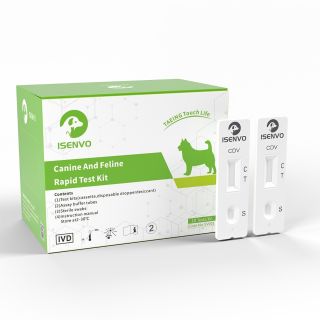As a pet owner, one of the greatest fears is seeing your beloved dog fall ill. Canine Distemper Virus (CDV), a highly contagious disease, poses a significant threat to canine health. Today, let's delve into the symptoms dogs exhibit after contracting CDV and how to manage this illness.
Overview of CDV Virus
Canine Distemper Virus (CDV) is the primary pathogen causing canine distemper, belonging to the Paramyxoviridae family, Morbillivirus genus. This virus not only infects canines but can also affect mustelids and some raccoon species. CDV is highly transmissible, spreading through direct contact with infected animals, air, or contaminated food. Once infected, a dog’s immune system is severely compromised, leading to damage to multiple organ systems.
Symptoms of CDV Infection
CDV symptoms vary widely, influenced by viral virulence, environmental conditions, the host’s age, and immune status. Based on the site of infection and disease severity, symptoms can be categorized as follows:
- Respiratory Symptoms
- Initial signs include fever, dry nose, and purulent nasal/ocular discharge.
- Coughing, rapid breathing, and lung rales (similar to cold or pneumonia symptoms).
- Swollen eyelids with purulent conjunctivitis, often leading to corneal ulcers.
- Gastrointestinal Symptoms
- Vomiting and diarrhea are common. Initially, constipation may occur, followed by foul-smelling, bloody, or bubbly stools.
- Puppies with severe diarrhea may develop intussusception, worsening their condition.
- Neurological Symptoms
- Approximately 10%–30% of infected dogs exhibit neurological signs, the most severe consequence of CDV.
- Symptoms include seizures, circling, abnormal posture, ataxia, salivation, and paroxysmal muscle twitching.
- Neurological signs typically indicate late-stage disease, with a poor prognosis.
- Dermatological Symptoms
- Less common but may include pustular dermatitis, hyperkeratosis of the nose or paw pads.
- Small red spots, edema, and purulent papules may appear on the lower abdomen and inner thighs.
- Other Symptoms
- Pregnant dogs may experience miscarriage, stillbirth, or weak offspring.
- Puppies infected in utero may develop neurological symptoms at 28–42 days.
- Newborns infected before permanent teeth erupt may suffer severe enamel damage and irregular tooth growth.
Stages and Symptom Progression of CDV Infection
CDV infection typically progresses through three stages:
- Early Stage (Respiratory Symptoms Dominant)
- Fever with a biphasic pattern (recurrent spikes).
- Prominent respiratory symptoms like coughing, sneezing, and nasal discharge.
- Middle Stage (Gastrointestinal Symptoms Intensify)
- Worsening vomiting and diarrhea.
- Puppies may develop complications such as intussusception.
- Late Stage (Neurological Symptoms Appear)
- Gradual onset of neurological signs like seizures, tremors, and ataxia.
- Rapid deterioration and poor prognosis.
Responding to CDV Infection
Prevention and treatment are equally crucial in managing CDV.
Preventive Measures
- Vaccination: Regular CDV vaccination is the most effective preventive measure. Puppies typically start at 6–8 weeks, with boosters every 3–4 weeks until 16–20 weeks. Adult dogs require annual boosters.
- Hygiene and Disinfection: Maintain a clean living environment and disinfect regularly to reduce transmission risks.
- Avoid Contact: During outbreaks, limit exposure to crowded areas and sick dogs.
Treatment Approaches
- Symptomatic Treatment: Address specific symptoms (e.g., antipyretics for fever, antiemetics for vomiting).
- Supportive Care: Provide fluids and nutrition to stabilize vital signs and boost resistance.
- Antiviral Therapy: While no specific antiviral exists, drugs like interferons and transfer factors may offer symptomatic relief.
- Immunomodulation: Immune enhancers (e.g., polysaccharides from traditional Chinese medicine) can bolster the dog’s immunity.
Facing CDV Infection: To Treat or Euthanize?
When a dog contracts CDV, owners often face a difficult choice: continue treatment or opt for euthanasia?
Medically, CDV has a poor prognosis, especially with neurological involvement. Even if a dog survives, permanent sequelae like epilepsy or paralysis are common. Thus, if the condition is irreversible and treatment only prolongs suffering, euthanasia may be a humane option.
However, this does not mean abandoning hope. Early intervention during the initial stages can save lives. Owners should monitor their dogs closely, seek veterinary care promptly upon noticing symptoms, and follow medical advice.
CDV is a formidable threat to canine health, but proactive prevention, timely symptom recognition, and effective treatment can reduce its impact. Let’s cherish our time with our furry companions and strive to provide them with a healthy, joyful life.
This translation maintains the original article’s structure and intent while adapting medical terminology and cultural nuances for an English-speaking audience.










Validate your login